March

The name March comes from the Latin Martius, i.e. ‘of Mars’, the god of war, son of Jupiter and Junona. Old Bulgarians called it “birch month” – the birch trees grow leaves and give sap. Very early in the morning, before the month begins, the young girls get up so that Granny Marta does not piss on their eyes and make them feel sleepy the whole summer. The young ones must be the first to meet the willful old woman and thus she will be smiling and merry and the weather will be good and sunny. In March people don’t have their hair cut so that she does not “cut” their brains and they become stupid.
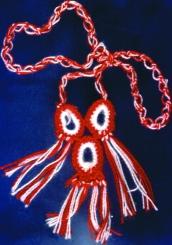 1
March MARTOUVANE (Martenitzas)
1
March MARTOUVANE (Martenitzas)
Many, many years ago, Khan Isperih left
his home in the far away Tibetan mountains and went in search of fertile
land for his people, the proto-Bulgarians. He crossed many mountains and
rivers until finally he stopped in the land of the Slavs who met him cordially.
Slav women, dressed in white, brought him cups of wine and the tables
were piled with food, the fruits of this blessed land. But the khan was
not happy for he was sick for his family – his mother and his sister
Kalina. He sat on the bank of the big river and tears like pearls dropped
down his masculine cheeks. His eyes looked in prayer towards the sun and
the gods. And the miracle happened. A swift swallow alighted on his shoulder.
Isperih told her his grief. The swallow flew away to the lands from which
the Bulgarians came and told Kalina in a human voice that her brother
has a new kingdom, that he grieves about her and sends her greetings.
Kalina was very happy to hear that and decided to send a message to her
brother. She made a nosegay of green plants, tied it with white woolen
thread, made some knots on it meaning best regards and sent it back
with the swallow. 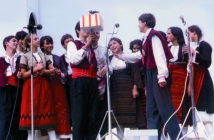 The
bird flew like thunder and very soon was on the shoulder of Isperih again.
But after the long journey its wing was wounded and bright red blood had
tinted the thread. The khan took the nosegay with joy, read in the knots
his sister’s greetings, put the nosegay on his breast and the martenitza
shone bright. Since then Isperih ordered his people to make a bunch of
twisted white and red thread and wear it on their breasts on this day
– for health and blessing from heaven. This happened on 1st of March
The
bird flew like thunder and very soon was on the shoulder of Isperih again.
But after the long journey its wing was wounded and bright red blood had
tinted the thread. The khan took the nosegay with joy, read in the knots
his sister’s greetings, put the nosegay on his breast and the martenitza
shone bright. Since then Isperih ordered his people to make a bunch of
twisted white and red thread and wear it on their breasts on this day
– for health and blessing from heaven. This happened on 1st of March
and has remained until this day. In the morning of 1st of March people
set fire in the yards of their houses, with lots of smoke. Then everybody
jumps over the fire three times, facing the rising sun, in order to be
purified from evil forces and guarded against diseases. The lady of the
house takes out red clothes and fabrics and puts them on the branches
of the trees in front of the house and on the fence. Only then she decorates
the children and the animals with the martenitzas made from woolen or
cotton thread.
Christians tell the story that many years ago, when people were merry
they dressed in white clothes. Thus on an early morning of 1st of March,
in the year when Jesus was to come among the people, Virgin Mary,
dressed in white, stood in the middle of the room in front of the fire,
cut a strip of her skirt and died it with her virgin blood. 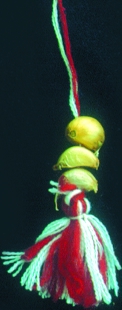 Then
she twisted it with another white strip and decorated her breast. She
went out on the verandah to meet the first rays of the sun and announce
to the universe the expected fertility
Then
she twisted it with another white strip and decorated her breast. She
went out on the verandah to meet the first rays of the sun and announce
to the universe the expected fertility
and to bless it… And Jesus Christ was born, consubstantial with
God the Father, incarnated by the Holy
Ghost and Virgin Mary – the Holy Mother. Since then the twisted
white and red is called “martenitza”. On the first day of
March all Bulgarian women, all children and the domestic animals are decorated
with it to be healthy, to be fertile and bring happiness to the family.
According to Christians living
along the river Tonsos, this Bulgarian custom is unique and expresses
homage to the Mother of God.
In the traditional Bulgarian martenitza women entwine coins, cloves of
dry garlic, beads, iron rings, hairs of horsetail, snail shells, etc.
That is why the martenitza is considered to be a charm against evil forces.
Children wear their martenitzas on the right wrist, around the neck or
on the breast, while young girls and brides wear it around the neck or
woven into their hair. Men, however, tie the martenitza above their left
elbow or left ankle. In some regions they put it in the shoe under the
left heel for if someone sees them with a martenitza their masculinity
may be “tied”. Martenitzas are tied on young animals and the
fruit trees.
People wear the martenitza until they see a stork. Then they tie it on
a fruit-tree branch, make a wish and are sure that it will come true.
Nameday of Marta, Martin.
6 March. Nameday of Krasimir, Krasimira, whom people call ‘decoration of the world’.
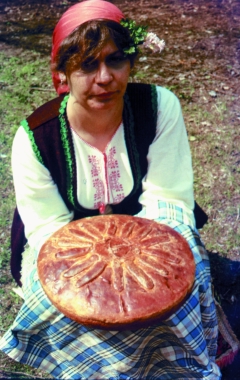 9
March MLADENTZI (The Day of the Holy Forty Martyrs)
9
March MLADENTZI (The Day of the Holy Forty Martyrs)
The Christian holiday Holy Forty Martyrs is also called “Svetoto”
or All Saints’ Day. A legend of the Bulgarians from the village
of Zelenovka, Tavria, tells how God on this day drives 40 red-hot spits
into the earth to warm it and “the sun turns towards summer”
and people can sow and plant. As a protection against measles women bake
small breads, cover them with honey, smoke them with incense and give
them out to neighbors for the health of the children. Every housewife
on this day cooks 40 red
peppers stuffed with rice. Everyone tries to eat 40 different things on
this day. People don’t kill birds, don’t scald wool so as
not to
make Grandmother Measles angry. Children go up a high hill, roll down
stones and say: "Roll out, Winter, roll in Summer!"
On that day snakes and lizards come out of their holes. People light fires,
jump over them and get in the smoke to banish evil
forces. The one who kills a snake on that day must cut its head, put seeds
of sweet basil in it and bury it into the ground. The seedlings that grow
out of them are magical. Lasses and lads, decorated with nosegays of such
basil, are protected against diseases and evil eyes and make others fall
head over heels in love with them. (The Day of the Holy Forty Martyrs)
10 March. Nameday of Galya, Galyo, which means ‘black, tawny’.
23 March. Nameday of Lydia. “Lida” in the folk beliefs is
a “spoilt lass”.
24 March. Nameday of Zahari, Zaharina. The name comes from Hebrew and
means ‘God remembers’.
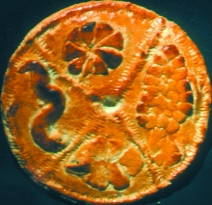 25
March BLAGOVESHTENIE (The Annunciation) (Blagovetz)
25
March BLAGOVESHTENIE (The Annunciation) (Blagovetz)
To meet the summer clean and tidy people sweep their yards and their
houses before Blagovetz, and the garbage is always burnt in order to burn
the illnesses of the year. On Blagovetz women sow pumpkins so
they will become white and mellow, while the silk-worm breeders put silk-worm
eggs in their bosoms and watch that the weather on this day is good so
that the year will be rich and the silk produced will be good.
People open the bee hives and let the bees out to collect sweet honey.
On Blagovetz people meet the storks and the swallows. This is also a festive
day for the children who, on seeing a bird, cry merrily at the sky: “Stork,
motley and long-legged, bring me health with hellebore!”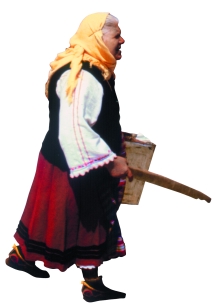 Maidens for whom it is time to get married, on seeing a swallow, are quick
to tie three knots on their kerchiefs and pronounce with hope: “Swallow,
my dear sister, give me a sign what man will take me!” They put
the kerchief on top of the oven to stay there for three days and three
nights, after which they take it in their hands and start divining: If
they notice mud on the cloth
Maidens for whom it is time to get married, on seeing a swallow, are quick
to tie three knots on their kerchiefs and pronounce with hope: “Swallow,
my dear sister, give me a sign what man will take me!” They put
the kerchief on top of the oven to stay there for three days and three
nights, after which they take it in their hands and start divining: If
they notice mud on the cloth
– the bridegroom will be a builder, if they find a scrap of paper
– he will be a teacher… Everybody on this day, before hearing
the song of the cuckoo, tries to be well fed, to have money in the pocket
and a good
feeling at heart, in order to be content, rich and joyful during the year.
Blagovetz is also celebrated by the treasure- hunters. It is believed
that at places where there is money buried in the ground, late in the
night before Blagovetz the coins emanate a blue glow above the earth.
That is why from midnight until the first crow of the rooster treasure-hunters
visit mounds, dry wells and deserted places, hoping to see the glow which
will give them riches. The nameday of Blagoy, Blagovesta.
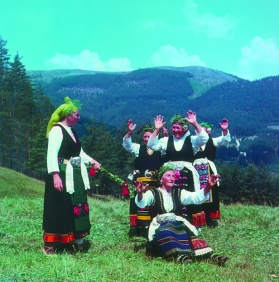 28–31
March BABINI DNI
28–31
March BABINI DNI
(Granny Marta’s Days)
Long, long ago, when the days of Granny Marta were 28 in number, in a
little village tucked away in the mountain there lived a quarrelsome old
woman with her two white goats. On the last day of the month the sun shone
and the old woman took the goats to the hill to get some sun and graze
young sprouts. But being a shrew, she didn’t miss
making fun of Granny Marta for her going away and cried at the forest:
“Marta – parta, go away, I took out my goats, be-e-e-…”
Granny Marta grew angry but her time was running out. She flew to her
brother February and asked him to borrow three of his days. Like a good
little brother, February gave them to her. Then Granny Marta started
raging, piercing whirlwinds blew and the ground was frozen with ice. The
old woman and her two goats were frozen too. From that day Marta grew
with three days and the people respect these days. They don’t work
in the fields lest they should make the granny angry. In some villages
these days are called "borrowed" and people sow beans by their
houses for they grow to be sweeter. If the weather is clear and nice,
people know that silkworms in the spring will be healthy and there will
be much silk. If the days are cloudy and rainy, the silkworms will be
weak and the fruit will not grow well.